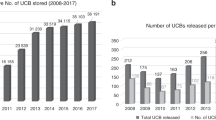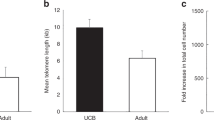Abstract
Cord blood (CB) units are increasingly used for allogeneic transplantation. Cell dose, a major factor for CB selection, is evaluated before freezing by each CB bank, using various techniques. This may introduce variability and affect the prediction of cell recovery after thawing, or haematopoietic reconstitution. Forty-two children were transplanted at the same institution with unrelated CB units. All units were thawed and evaluated at the same cell therapy facility, using standard procedures. We investigated: (i) factors that affect cell loss after thawing, and (ii) the importance of CD34+ cell doses. Prefreeze and post-thaw CD34+ cell doses were statistically correlated, thus suggesting that variability in numeration techniques used by different CB banks does not compromise the biological and clinical value of these figures. CD34+ cell recovery appeared to be correlated with the absolute number of CD34+ cells per frozen bag. Infused CD34+ is the cell dose that better correlates with platelet reconstitution delay; in addition, when using a quartile comparison, haematopoietic recovery appeared to be related with prefreeze and post-thaw CD34+ cell doses. We conclude that enumeration of CD34+ cells in CB units is of biological significance, and may help select CB units and identify patients at risk of delayed recovery.
This is a preview of subscription content, access via your institution
Access options
Subscribe to this journal
Receive 12 print issues and online access
$259.00 per year
only $21.58 per issue
Buy this article
- Purchase on Springer Link
- Instant access to full article PDF
Prices may be subject to local taxes which are calculated during checkout



Similar content being viewed by others
References
Szydlo R, Goldman JM, Klein JP, Gale RP, Ash RC, Bach FH et al. Results of allogeneic bone marrow transplants for leukemia using donors other than HLA-identical siblings. J Clin Oncol 1997; 15: 1767–1777.
Kernan NA, Bartsch G, Ash RC, Beatty PG, Champlin R, Filipovich A et al. Analysis of 462 transplantations from unrelated donors facilitated by the National Marrow Donor Program. N Engl J Med 1993; 328: 593–602.
Takahashi S, Iseki T, Ooi J, Tomonari A, Takasugi K, Shimohakamada Y et al. Single-institute comparative analysis of unrelated bone marrow transplantation and cord blood transplantation for adult patients with hematologic malignancies. Blood 2004; 104: 3813–3820.
Lansdorp PM, Dragowska W, Mayani H . Ontogeny-related changes in proliferative potential of human hematopoietic cells. J Exp Med 1993; 178: 787–791.
Risdon G, Gaddy J, Horie M, Broxmeyer HE . Alloantigen priming induces a state of unresponsiveness in human umbilical cord blood T cells. Proc Natl Acad Sci USA 1995; 92: 2413–2417.
Holyoake TL, Nicolini FE, Eaves CJ . Functional differences between transplantable human hematopoietic stem cells from fetal liver, cord blood, and adult marrow. Exp Hematol 1999; 27: 1418–1427.
Barker JN, Davies SM, DeFor T, Ramsay NK, Weisdorf DJ, Wagner JE . Survival after transplantation of unrelated donor umbilical cord blood is comparable to that of human leukocyte antigen-matched unrelated donor bone marrow: results of a matched-pair analysis. Blood 2001; 97: 2957–2961.
Laughlin MJ, Eapen M, Rubinstein P, Wagner JE, Zhang MJ, Champlin RE et al. Outcomes after transplantation of cord blood or bone marrow from unrelated donors in adults with leukemia. N Engl J Med 2004; 351: 2265–2275.
Rocha V, Labopin M, Sanz G, Arcese W, Schwerdtfeger R, Bosi A et al. Transplants of umbilical-cord blood or bone marrow from unrelated donors in adults with acute leukemia. N Engl J Med 2004; 351: 2276–2285.
Wagner JE, Kernan NA, Steinbuch M, Broxmeyer HE, Gluckman E . Allogeneic sibling umbilical-cord-blood transplantation in children with malignant and non-malignant disease. Lancet 1995; 346: 214–219.
Gluckman E, Rocha V, Boyer-Chammard A, Locatelli F, Arcese W, Pasquini R et al. Outcome of cord-blood transplantation from related and unrelated donors. Eurocord Transplant Group and the European Blood and Marrow Transplantation Group. N Engl J Med 1997; 337: 373–381.
Rubinstein P, Carrier C, Scaradavou A, Kurtzberg J, Adamson J, Migliaccio AR et al. Outcomes among 562 recipients of placental–blood transplants from unrelated donors. N Engl J Med 1998; 339: 1565–1577.
Rocha V, Wagner Jr JE, Sobocinski KA, Klein JP, Zhang MJ, Horowitz MM et al. Graft-versus-host disease in children who have received a cord-blood or bone marrow transplant from an HLA-identical sibling. Eurocord and International Bone Marrow Transplant Registry Working Committee on Alternative Donor and Stem Cell Sources. N Engl J Med 2000; 342: 1846–1854.
Kurtzberg J, Laughlin M, Graham ML, Smith C, Olson JF, Halperin EC et al. Placental blood as a source of hematopoietic stem cells for transplantation into unrelated recipients. N Engl J Med 1996; 335: 157–166.
Locatelli F, Rocha V, Chastang C, Arcese W, Michel G, Abecasis M et al. Factors associated with outcome after cord blood transplantation in children with acute leukaemia. Eurocord-Cord Blood Transplant Group. Blood 1999; 93: 3662–3671.
Gluckman E, Rocha V, Arcese W, Michel G, Sanz G, Chan KW et al. Factors associated with outcomes of unrelated cord blood transplant: guidelines for donor choice. Exp Hematol 2004; 32: 397–407.
Wagner JE, Rosenthal J, Sweetman R, Shu XO, Davies SM, Ramsay NK et al. Successful transplantation of HLA-matched and HLA-mismatched umbilical cord blood from unrelated donors: analysis of engraftment and acute graft-versus-host disease. Blood 1996; 88: 795–802.
Hamza NS, Lisgaris M, Yadavalli G, Nadeau L, Fox R, Fu P et al. Kinetics of myeloid and lymphocyte recovery and infectious complications after unrelated umbilical cord blood versus HLA-matched unrelated donor allogeneic transplantation in adults. Br J Haematol 2004; 124: 488–498.
Rivadeneyra-Espinoza L, Perez-Romano B, Gonzalez-Flores A, Guzman-Garcia MO, Carvajal-Armora F, Ruiz-Arguelles A . Instrument- and protocol-dependent variation in the enumeration of CD34+ cells by flow cytometry. Transfusion 2006; 46: 530–536.
Moroff G, Eichler H, Brand A, Kekomaki R, Kurtz J, Letowska M et al. Multiple-laboratory comparison of in vitro assays utilized to characterize hematopoietic cells in cord blood. Transfusion 2006; 46: 507–515.
Rubinstein P, Dobrila L, Rosenfield RE, Adamson JW, Migliaccio G, Migliaccio AR et al. Processing and cryopreservation of placental/umbilical cord blood for unrelated bone marrow reconstitution. Proc Natl Acad Sci USA 1995; 92: 10119–10122.
Olivero S, Alario T, Ladaique P, Haccoun M, Viens P, Blaise D et al. CD34+ cell enumeration in peripheral blood and apheresis samples, using two laboratory diagnostic kits or an institutional protocol. Bone Marrow Transplant 1999; 23: 387–394.
Nicholson JK, Velleca WM, Jubert S, Green TA, Bryan L . Evaluation of alternative CD4 technologies for the enumeration of CD4 lymphocytes. J Immunol Methods 1994; 177: 43–54.
Solves P, Mirabet V, Planelles D, Blasco I, Perales A, Carbonell-Uberos F et al. Red blood cell depletion with a semiautomated system or hydroxyethyl starch sedimentation for routine cord blood banking: a comparative study. Transfusion 2005; 45: 867–873.
Wagner JE, Barker JN, DeFor TE, Baker KS, Blazar BR, Eide C et al. Transplantation of unrelated donor umbilical cord blood in 102 patients with malignant and nonmalignant diseases: influence of CD34 cell dose and HLA disparity on treatment-related mortality and survival. Blood 2002; 100: 1611–1618.
Laroche V, McKenna DH, Moroff G, Schierman T, Kadidlo D, McCullough J . Cell loss and recovery in umbilical cord blood processing: a comparison of postthaw and postwash samples. Transfusion 2005; 45: 1909–1916.
Wagner E, Duval M, Dalle JH, Morin H, Bizier S, Champagne J et al. Assessment of cord blood unit characteristics on the day of transplant: comparison with data issued by cord blood banks. Transfusion 2006; 46: 1190–1198.
Solves P, Mirabet V, Carbonell-Uberos F, Soler A . CD34+ cell content before freezing represents the hematopoietic stem cell content of thawed and washed cord blood units. Transfusion 2005; 45: 116–117; author reply 117–118.
Stevens CE, Gladstone J, Taylor PE, Scaradavou A, Migliaccio AR, Visser J et al. Placental/umbilical cord blood for unrelated-donor bone marrow reconstitution: relevance of nucleated red blood cells. Blood 2002; 100: 2662–2664.
Armitage S, Fehily D, Dickinson A, Chapman C, Navarrete C, Contreras M . Cord blood banking: volume reduction of cord blood units using a semi-automated closed system. Bone Marrow Transplant 1999; 23: 505–509.
Godinho MI, de Sousa ME, Carvalhais A, Barbosa IL . Umbilical cord blood processing with the Optipress II blood extractor. Cytotherapy 2000; 2: 439–444.
Regidor C, Posada M, Monteagudo D, Garaulet C, Somolinos N, Fores R et al. Umbilical cord blood banking for unrelated transplantation: evaluation of cell separation and storage methods. Exp Hematol 1999; 27: 380–385.
Migliaccio AR, Adamson JW, Stevens CE, Dobrila NL, Carrier CM, Rubinstein P . Cell dose and speed of engraftment in placental/umbilical cord blood transplantation: graft progenitor cell content is a better predictor than nucleated cell quantity. Blood 2000; 96: 2717–2722.
Davey S, Armitage S, Rocha V, Garnier F, Brown J, Brown CJ et al. The London Cord Blood Bank: analysis of banking and transplantation outcome. Br J Haematol 2004; 125: 358–365.
Acknowledgements
We thank V Rocha and F Garnier from Eurocord; D Reviron and C Picard for CB selection and HLA typing; I Sielleur for flow cytometry analysis and D. Sandragne for access to patient databases. This work was supported in part by Institut Paoli-Calmettes, and by a grant from the EEC to CC (Eurocord III Program). This work was presented in part at the 2006 EBMT Annual meeting in Hamburg, Germany, and at the 2006 ISCT Annual meeting, in Berlin, Germany.
Author information
Authors and Affiliations
Corresponding author
Rights and permissions
About this article
Cite this article
Lemarie, C., Esterni, B., Calmels, B. et al. CD34+ progenitors are reproducibly recovered in thawed umbilical grafts, and positively influence haematopoietic reconstitution after transplantation. Bone Marrow Transplant 39, 453–460 (2007). https://doi.org/10.1038/sj.bmt.1705618
Received:
Revised:
Accepted:
Published:
Issue Date:
DOI: https://doi.org/10.1038/sj.bmt.1705618



